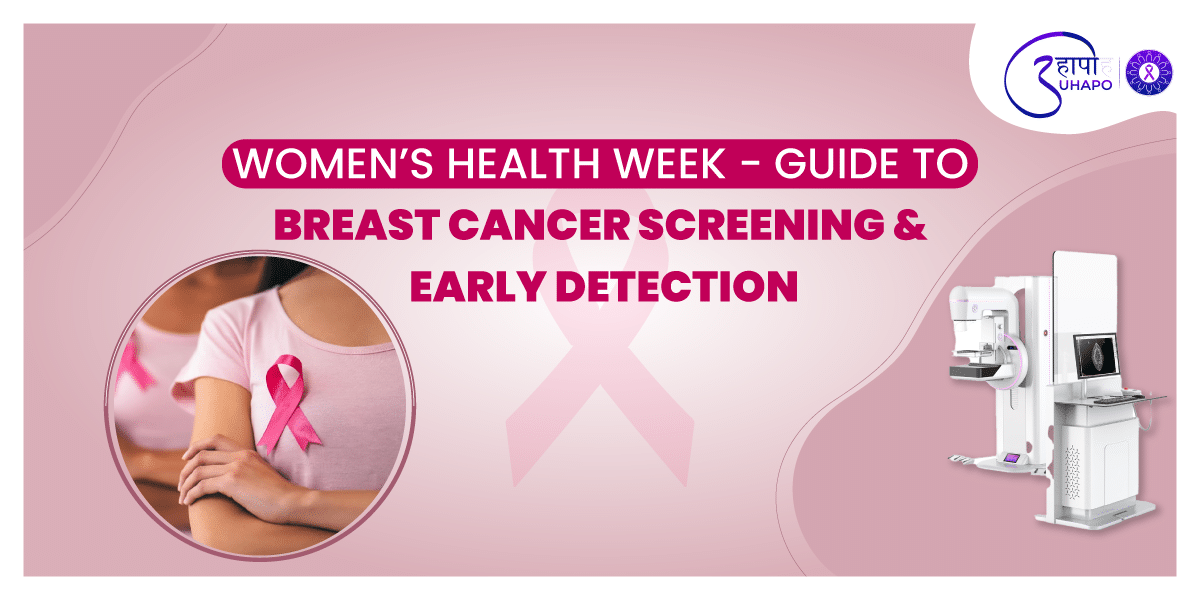Women’s Health Week – Guide to Breast Cancer Screening and Early Detection
Women’s Health Week is a crucial reminder for women everywhere to prioritize their health and well-being. Among the many important health issues that women face, breast cancer stands out as one of the most significant. Early detection through regular screening is a powerful tool in combating breast cancer, potentially saving lives by identifying the disease at its most treatable stages.
This guide aims to provide essential information on breast cancer screening and early detection, empowering women to take proactive steps in maintaining their health.
Understanding Breast Cancer
Breast cancer is the most common cancer in women worldwide. This occurs when cells in the breast grow out of control to forming a tumor that spread easily to other parts of the body. Although the exact cause of breast cancer is unknown, yet certain risk factors can increase a woman’s chances of developing the disease. These include lifestyle factors such as age, genetic predisposition (such as BRCA1 and BRCA2 gene mutations), family history, personal history of breast cancer, breast density, alcohol consumption, and obesity.
Importance of Early Detection
Early detection of breast cancer greatly improves the chances of successful treatment. When detected early, breast cancer tends to be localized, which means it doesn’t spread beyond the breast, making it easier to treat. The five-year survival rate for localized breast cancer is about 99%, compared with 27% for cancer that has spread to distant parts of the body therefore routine screening is an important strategy to adopt treating the disease before it progresses.
Types of Breast Cancer Screening
Several methods have been used to screen for breast cancer, each with advantages and limitations. Common screening methods include –
Breast examination
Mammography is the most common screening tool for breast cancer. It uses low-dose X-rays to capture images of breast tissue, allowing radiologists to spot abnormalities. There are two types of mammograms – screening mammograms for women who have no symptoms, and mammograms for detecting tumors or other symptoms. Women are generally advised to begin regular mammograms in their 40s and 50s , depending on risk factors, and should continue annually or bi-annually.
Breast MRI
Magnetic Resonance Imaging (MRI) is typically used for women at high risk of breast cancer, such as those with BRCA1 or BRCA2 mutations or a strong family history. MRI uses magnetic fields and radio waves to produce detailed images of the breast. It is more sensitive than mammography and can detect cancers that mammograms might miss, but it is also more likely to produce false positives.
Breast Ultrasound
Ultrasound uses sound waves to create images of the breast tissue. It is often used as a supplementary tool to mammography, especially in women with dense breast tissue, where mammograms might be less effective. Ultrasound can help distinguish between solid tumors and fluid-filled cysts.
Clinical Breast Exam (CBE) and Self-Exam
A Clinical Breast Exam is performed by a healthcare provider who checks for lumps or other changes. Breast self-exams, where women check their own breasts for lumps or changes, are no longer universally recommended as a screening tool but can help women become familiar with their breasts and notice any changes promptly.
Guidelines for Screening
Breast cancer screening guidelines can vary based on an individual’s risk factors. Here are some general recommendations –
- Average Risk Women
- Ages 40-49 – Discuss with your doctor about when to start screening.
- Ages 50-74 – Mammograms every 1-2 years.
- Ages 75 and older – Continue screening based on health status and personal preference.
- High-Risk Women
- May need to start screening earlier (often at age 30) and may require additional methods like MRI along with mammograms.
Personalizing Your Screening Plan
Women should discuss their individual risk factors with their healthcare providers to develop a personalized screening plan. Factors like family history, genetic predispositions, and personal health history play a critical role in determining the most appropriate screening strategy.
Reducing Breast Cancer Risk
In addition to regular screening, there are several lifestyle changes women can make to reduce their risk of developing breast cancer –
- Maintain a Healthy Weight – Obesity, particularly after menopause, increases breast cancer risk.
- Exercise Regularly – Physical activity helps maintain a healthy weight and balance hormone levels.
- Limit Alcohol Consumption – The risk of breast cancer increases with alcohol intake.
- Eat a Balanced Diet – A diet rich in fruits, vegetables, and whole grains can support overall health.
- Avoid Smoking – Smoking is linked to a higher risk of many cancers, including breast cancer.
Conclusion
Women’s Health Week serves as a powerful reminder to prioritize health through awareness and proactive measures. Breast cancer screening and early detection are critical components in the fight against breast cancer. By understanding the various screening options, ensuring to recommended guidelines, and making healthy lifestyle choices, women can significantly reduce their risk and improve their chances of successful treatment. This week, take the time to discuss your breast cancer screening plan with your healthcare provider and encourage the women in your life to do the same. Your health is worth it.


3 Replies to “Boosting Women’s Health: Your Ultimate Breast Cancer Screening & Early Detection Guide”
December 18, 2024
August 6, 2025
July 6, 2025